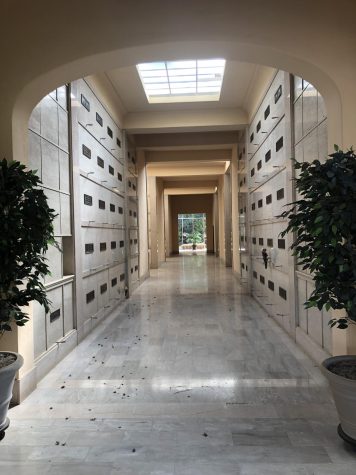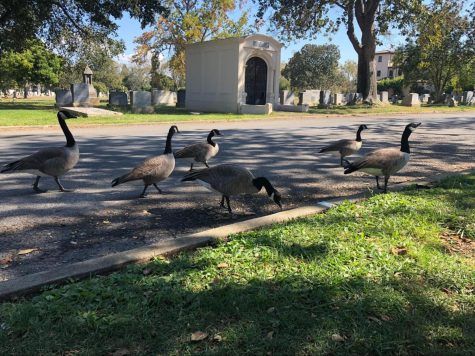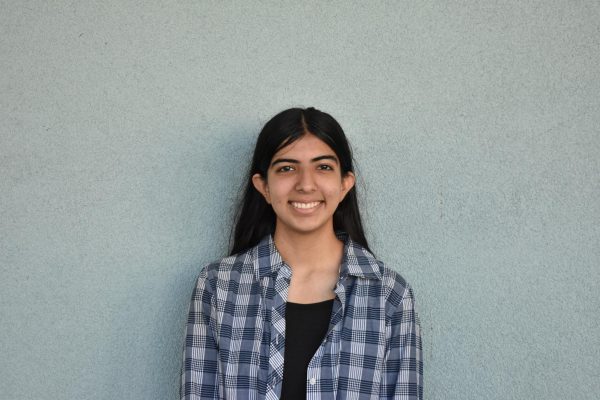Alta Mesa Cemetery furnishes final resting place for many, touches neighbors’ lives
It’s just a quick walk away. If you venture out of Gunn’s parking lot and turn left on Arastradero, you’ll soon encounter its gates, with its name spelled out boldly in all caps: “Alta Mesa Cemetery and Funeral Home.”
Most students don’t continue beyond this point, but those who do will find that Alta Mesa Memorial Park, the non-denominational private cemetery across the street from Gunn, is more than what meets the eye: It encompasses upwards of 70 acres in area and over a century in history.

In order to address a shortage of cemeteries in the area, Alta Mesa was established in 1904 (just over a decade after the official incorporation of the city of Palo Alto). According to an original brochure from Alta Mesa, prior to its establishment, there was only one cemetery in the region running from Palo Alto to Sunnyvale. To remedy this issue, individuals from Palo Alto, Mayfield, Mountain View and Sunnyvale met to organize the Alta Mesa Improvement Company, which operates the memorial park and funeral home today. The land, dubbed “Alta Mesa” (meaning “high plain” in Spanish) because of its location, was then plotted and laid out by a “competent landscape gardener,” in the words of the brochure.
The cemetery has only grown since then. According to its website, it now includes three mausoleums, a crematory and a funeral home, among other additions. Buried within its vast acreage are countless people, both relatively obscure and well-known.

Take, for example, the first person buried at Alta Mesa: Margery J. Foster (née McKee). Born in Kentucky in 1832, she spent much of her life in Indiana before moving to Palo Alto in 1904, a few years before her death at 71 years old. She lived to see the United States through some of its most tumultuous moments yet—including the Civil War, in which her husband served as a part of Tennessee’s hospital service, according to The Peninsula Times Tribune.
Also buried in the cemetery is Richard F. Leake, who was born in English Canada in 1868, a few years after the end of the Civil War and 18 years after California achieved statehood. He worked at a grocery store chain in San Jose before moving to Sacramento, California, in 1916. There, he managed a store and worked for the Wholesale Credit Association, according to The Sacramento Bee. He died on Jan. 9, 1952.
Almost 60 years later, Steven Paul Jobs—better known as Steve Jobs—was laid to rest at Alta Mesa. Born in San Francisco, California, in 1955, Jobs grew up with his adoptive parents in the Bay Area. After dropping out of Reed University, he co-founded what would go on to become one of the largest technology companies in the world: Apple Computer Company.
Separated by distance and time in life, Foster, Leake and Jobs now lie near one another in death—and they’re just three of thousands buried Alta Mesa. Among their ranks are also actress Shirley Temple, pianist Adolph Baller, writer Kathleen Norris, Hewlett-Packard co-founder David Packard and his wife, hospital founder Lucile Packard.
Sixty years after Alta Mesa’s first burial, Gunn officially opened its doors on Arastradero Road, almost directly across the road from Alta Mesa. Though the cemetery’s presence may not profoundly impact students at Gunn, Advanced Placement (AP) Psychology teacher Warren Collier noted that it could potentially change how often they think about their mortality. “If students are walking past it every day, it might make a difference in terms of how often they think about death, how often they think about loved ones who have passed on,” he said. “[Students are being] reminded on a regular basis that this is a thing that happens—that cemeteries exist and that people can die.”
The cemetery’s location also invites comparisons between Gunn’s campus and that of Palo Alto High School (Paly), which is across the street from Town and Country. Junior Andre Young was among those who noted the differences between the two locations. “It makes me very sad to look at [the cemetery] because it seems to be very dreary,” he said. “The main reason why I like Paly’s location more than Gunn’s is because you can’t eat anything at the cemetery—unless you’re brave enough.”
Still, for those who have ventured inside the cemetery, such as junior Michael Ibrahim, it’s not all gloom and doom. Ibrahim, who’s lived near Alta Mesa for around six years now, doesn’t visit the cemetery often—after all, it’s not your typical teenage hangout spot. On the occasions that he has come by, however, he’s found it to be quite pleasant. “We’ve walked around there a couple of times,” he said. “It was actually really nice—they have flowers everywhere, and it’s really open.”
Though freshman Saniya Sajith hasn’t been inside the cemetery, she also has a favorable impression of it. “When I come in the morning every day on the bus, I see [the cemetery] and it looks very pretty,” she said. “I know there are really cool statues and tombs in there.”
There’s more to Alta Mesa than the aesthetics: Collier noted that cemeteries serve as a reminder of an ages-old tradition defining the human species and its way of coming to terms with its mortality. “We have a special relationship with our dead that other species do not have,” he said. “[Cemeteries are] not always sad or depressing. They can also just be a place to respect, to honor, to celebrate.”
This fits with Alta Mesa Office Manager Alex Wood’s assessment of what the staff hopes to accomplish. “We help families by guiding them in the process of memorializing, celebrating or interring their loved one either at Alta Mesa or at other locations,” she wrote in an email. “Alta Mesa’s future and goal will always be to help and support as many people as we can during such difficult circumstances.”

Alta Mesa attempts to encapsulate that bittersweet mix of solemnity and celebratory spirit, and it’s evident from just a few steps inside the gates. Planted amongst the tombs are trees of different varieties—most notably oak—dappling the light and providing some much-needed shade. The graves themselves are adorned with multifarious objects: Flowers, pinwheels, American flags and even scarecrows sit upon the names of those who have passed. The cemetery also seems to be a sanctuary for all species—one might catch a glimpse of geese waddling among the gravestones, foraging for a quick bite (true story).
Although the cemetery may not be foremost on students’ minds at Gunn, Collier hopes that it serves as a reminder for those in the community to display solidarity. “We try to do something for those who are dead—a lot of people like to believe that things happen after we die,” he said. “That sense of belonging, that sense of togetherness continues. I would hope that places like cemeteries could remind people to stick together and be there for each other.”
Your donation will support the student journalists of Henry M. Gunn High School. Your contribution will allow us to purchase equipment and cover our annual website hosting costs.

Senior Amann Mahajan is the editor-in-chief of The Oracle and has been on staff since January 2022. When she’s not reporting, she enjoys solving crosswords,...

